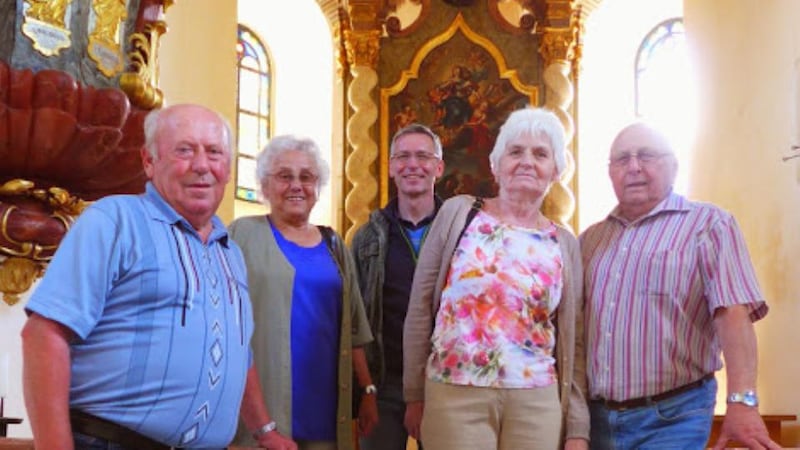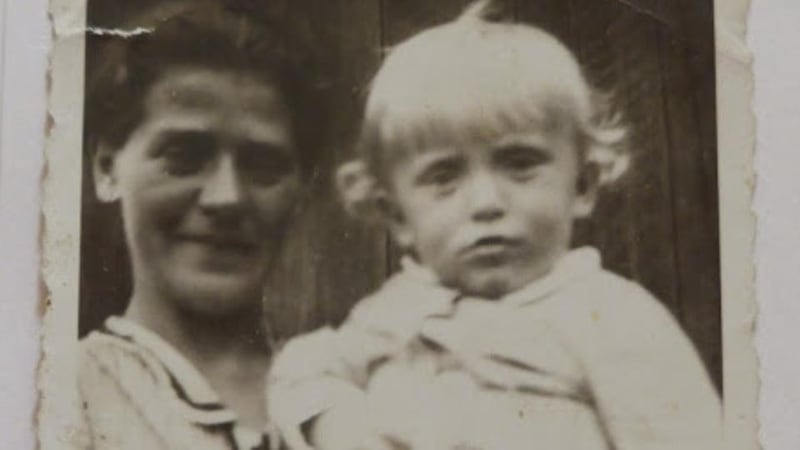The yellow mongrel bares its yellow teeth from behind the garden fence and starts barking at us. Then the black dog next door starts up. Soon the canine chorus has alerted everyone in Olešná, a tiny Czech village in western Bohemia, to the strangers walking down the dusty road.
This trip is not starting well, I think to myself, as I walk with Helmut Tauer around where he was born in 1939. Then the village was still called Elsch, until his family left forever in 1946, the last of the village’s 200 ethnic German residents. Now Helmut is back, showing me the grassy gap between two crumbling houses where his home once stood.
“Most of the rubble is still there, that’s why it’s so hilly,” he says. “Over there [he points to one corner of the small site] is where we buried the porcelain and a bit of crystal before we left.”


I've known Helmut, his wife Meta and their son Thomas for years. Helmut and Meta live in a pretty house near the eastern German city of Magdeburg. But, for Helmut, home is here in Elsch. After years of hearing stories of his old Heimat (homeland), we have driven 350km southeast, through a pretty rolling landscape, to visit.
The dogs finally stop yowling when we reach the back of the vacant site. Helmut’s round face lights up as he recognises a red-brick pillar as a bit of the old garden wall. As a warm summer breeze blows over us, I shiver at the feeling that ghosts are watching us.
When Helmut was born here, on August 7th, 1939, this German-speaking region, the Sudetenland, had already, in Nazi parlance, “returned to the Reich”. In reality it had been annexed by Hitler from Czechoslovakia, a move accepted by the West to appease the Nazi leader.
Their hopes of avoiding war were dashed on September 3rd, 1939, when Nazi troops marched into Poland and triggered the second World War. This part of Sudetenland's history – as an appeasement pawn – is well known. What happened before and after, less so.
The Sudetenland, including this region of Bohemia, was part of the sprawling Austrian-Hungarian empire for centuries, then an independent Czechoslovak state after 1918. When the new government in Prague introduced policies discriminating against the ethnic Germans living here since the 13th century, it fired up Sudeten separatist sentiment.
Political wrangling
Adolf Hitler’s offer to join his Third Reich was embraced by the Sudetens as the promise of a secure future and an end to discrimination. Such political wrangling took place far away from Elsch. Helmut’s father, Anton, was a builder, and was often away for months at a time, leaving his wife, Theresia, to raise their three children: Helmut; his older brother, Walter; and younger sister, Gerlinde.
Their modest, whitewashed family home had three rooms, with a stall for pigs and cows attached and about four hectares of land. Their house is gone, but the rest of the village survives: a collection of crumbling houses, some new residences and a church disintegrating quietly in a copse.
Helmut strolls down a shady lane towards the forest where, with his dog Mandor, he once gathered mushrooms and blueberries. The war barely touched Elsch until the US army rolled through on May 4th, 1945, he says. For the 200 German- speaking villagers, the real disaster was still ahead. In London, the Czech government-in-exile under president Edvard Beneš had secured Allied agreement to return his post-war country to its pre-1938 borders and expel all German-speakers to the west.
Population shifts were nothing new, but when details of the Allied plan emerged, the New York Times sounded the alarm. Was it realistic to move more people around Europe in a few months than had migrated to the US in the previous 30 years, it asked, via an infrastructure the Allies had spent the previous years trying to destroy?
In London, the Economist warned that post-war punishment "must fall on those who are guilty in the moral and not in a racial sense. The Nazis have made racial scapegoats, the Allies must not fall into exactly the same error."
Foreign Office officials in London examined the logistics and warned that the plan’s political merit – resettling European ethnic populations inside national borders to prevent future tensions – was overshadowed by the risk of mass human suffering. Disastrous pre-war resettlements by Hitler and Stalin in the Baltics had shown that.
Ultimately, the Allies accepted the Czech arguments, later laid down in the infamous Beneš decrees, that the German-speakers were “passive war criminals” who should be expelled without compensation. The Sudeten Germans were in a catch-22 situation: rejecting the expulsion plan would deliver further “proof” of their reputation as Hitler’s “fifth column”; accepting the expulsion meant losing everything.
There was little time to protest. Even before the war ended, the first wave of “wild” expulsions began in the Sudetenland. German-speakers were marched by Czechs into the wilderness and dumped across the border; others were shot.
The “official” wave, regulated by the Allied post-war Potsdam Agreement, urged “orderly and humane” expulsions, but instead, the wartime horror – camps, cattle trucks, terror and disease – rolled on into 1946 and 1947, this time directed against the German speakers in new Polish and Czech territories. Some families got two hours’ notice to leave, others 10 minutes to find their children, grab what they could and flee.
The evacuation
“The mayor came and told us, ‘In two days you will be collected, brought to a camp and then evacuated’,” says Franz Sandner (79), Helmut’s cousin, from the nearby village of Altsattl. “We were allowed 40kg of clothes and food and spent eight days on a train.”
In the second week of August 1946, Helmut’s family packed up clothes, pots, crockery, feather beds, tinned foods, tools. Then the two adults and three children – all obliged to wear white armbands of expellees – boarded a truck and left Elsch behind. In a nearby town, the family boarded a cattle truck with dozens of other locals and were transported west, destination unknown.
“My mother and other adults hoped it was just a temporary thing, that we could return soon,” says Helmut, “but the farther west the train went, the more that hope dwindled. That hope died after about two years in our new home.”
While many relations were assigned to Bavaria in the US-occupied zone, Helmut Tauer’s family ended up in Gröningen in the Russian-occupied zone, later East Germany. Three hard years followed, scrabbling for food and struggling to start again.
“My mother never warmed to the place. In her thoughts she was always in Elsch,” says Helmut.
Seven decades on, the interest in the Hitler era remains insatiable. But little is known about what happened next: how around 12 million ethnic Germans were expelled from their homes in the post-war years, with an estimated 1.5 million losing their lives. For historian Ray Douglas, author of the masterly 2012 expulsion study Orderly and Humane, the mass amnesia is no accident. Germans are uncomfortable remembering the episode for fear of being seen as revisionists by drawing parallels with the terrible crimes that went before. For Poles and Czechs, their role in the expulsions complicates their national "victim" narratives.
For citizens of Allied countries, Douglas argues, ignoring the expulsions is preferable to admitting responsibility for one of modern history’s greatest human-rights abuses – an episode with uncomfortable parallels to Nazi era crimes. “Whatever occurred after the war cannot be possibly equated to the atrocities perpetrated by the Germans during it,” writes Douglas. “But it is a long way from there to conclude that the expulsion of the Germans was inevitable, necessary, or justified.”
Too cheery for tragedy
After a busy morning visiting old haunts, we are taking stock over lunch in a cosy pub. On paper, Helmut’s life story could read as tragedy: a lost homeland, a vanished home and a mother too broken-hearted to ever return for a visit. But Helmut is too cheery for tragedy. In his new home, he says, they were given straw to sleep on by a friendly local farmer. A few years later, Helmut married the farmer’s daughter, Meta, and they had two children.
As they eat, Helmut and his cousin Franz, both the far side of 70, are chattering like happy children about their Bohemian homeland, the juicy meat-and-dumplings dishes and the lilting brass-band music they love. There is no gloom on this trip, only Lebensfreude: joy for life. Even though history took it away, there is no place like home.
“I don’t know why I come back, but the place just draws me the older I get,” says Helmut. “I have no ill will towards the people living here; it’s their home now. At some point you have to draw a line under history.”
Before doing that, though, it’s important to know that history.
SUDETENLAND: WHISTLE-STOP TOUR
Ate: Bohemian bread dumplings with schnitzel.
Saw: A rolling green landscape with sleepy villages and dark forests.
Loved: Hearing a vanished way of life and a difficult history come alive – with joy and not bitterness.
Hated: The odd atmosphere of discontinuity. Few families living in Sudetenland now were here 70 years ago.
Would I do it again? Absolutely. Time is running out to learn about this forgotten chapter from witnesses.









